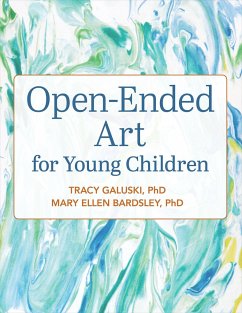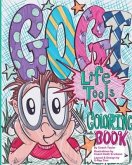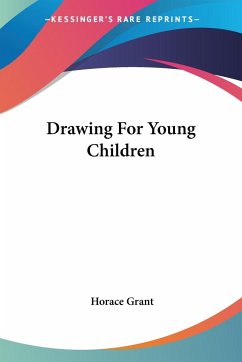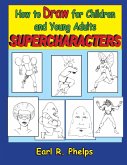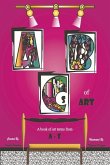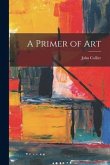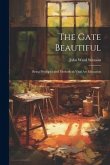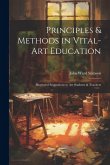Schade – dieser Artikel ist leider ausverkauft. Sobald wir wissen, ob und wann der Artikel wieder verfügbar ist, informieren wir Sie an dieser Stelle.
- Broschiertes Buch
- Merkliste
- Auf die Merkliste
- Bewerten Bewerten
- Teilen
- Produkt teilen
- Produkterinnerung
- Produkterinnerung
Open-ended art is defined as art activity where children are free to use their imagination as they explore a variety of materials without a planned outcome. This book highlights why the field of early childhood education advocates for open-ended art and explains how to adapt to new ways of thinking about art.
Andere Kunden interessierten sich auch für
![GOGI Life Tools Coloring Book GOGI Life Tools Coloring Book]() Coach TaylorGOGI Life Tools Coloring Book23,99 €
Coach TaylorGOGI Life Tools Coloring Book23,99 €![Drawing For Young Children Drawing For Young Children]() Horace GrantDrawing For Young Children17,99 €
Horace GrantDrawing For Young Children17,99 €![How to Draw for Children and Young Adults How to Draw for Children and Young Adults]() Earl R PhelpsHow to Draw for Children and Young Adults13,99 €
Earl R PhelpsHow to Draw for Children and Young Adults13,99 €![ABCs of Art: A Book of Art Terms from a - Z ABCs of Art: A Book of Art Terms from a - Z]() Tanyia BowldingABCs of Art: A Book of Art Terms from a - Z12,99 €
Tanyia BowldingABCs of Art: A Book of Art Terms from a - Z12,99 €![A Primer of Art A Primer of Art]() John CollierA Primer of Art17,99 €
John CollierA Primer of Art17,99 €![The Gate Beautiful: Being Principles and Methods in Vital Art Education The Gate Beautiful: Being Principles and Methods in Vital Art Education]() John Ward StimsonThe Gate Beautiful: Being Principles and Methods in Vital Art Education28,99 €
John Ward StimsonThe Gate Beautiful: Being Principles and Methods in Vital Art Education28,99 €![Principles & Methods in Vital-art Education: Illustrated Suggestions to art Students & Teachers Principles & Methods in Vital-art Education: Illustrated Suggestions to art Students & Teachers]() John Ward StimsonPrinciples & Methods in Vital-art Education: Illustrated Suggestions to art Students & Teachers18,99 €
John Ward StimsonPrinciples & Methods in Vital-art Education: Illustrated Suggestions to art Students & Teachers18,99 €-
Open-ended art is defined as art activity where children are free to use their imagination as they explore a variety of materials without a planned outcome. This book highlights why the field of early childhood education advocates for open-ended art and explains how to adapt to new ways of thinking about art.
Produktdetails
- Produktdetails
- Verlag: Redleaf Press
- Seitenzahl: 152
- Erscheinungstermin: 16. Oktober 2018
- Englisch
- Abmessung: 277mm x 213mm x 10mm
- Gewicht: 567g
- ISBN-13: 9781605545981
- ISBN-10: 1605545988
- Artikelnr.: 50568526
- Herstellerkennzeichnung
- Libri GmbH
- Europaallee 1
- 36244 Bad Hersfeld
- gpsr@libri.de
- Verlag: Redleaf Press
- Seitenzahl: 152
- Erscheinungstermin: 16. Oktober 2018
- Englisch
- Abmessung: 277mm x 213mm x 10mm
- Gewicht: 567g
- ISBN-13: 9781605545981
- ISBN-10: 1605545988
- Artikelnr.: 50568526
- Herstellerkennzeichnung
- Libri GmbH
- Europaallee 1
- 36244 Bad Hersfeld
- gpsr@libri.de
Dr. Tracy Galuski has worked in the field of early childhood education for many years. Serving initially as a toddler teacher, she moved into different roles such as preschool teacher, child care program administrator, training specialist with both the Child Care Resource Network and Success by 6 at the United Way, and finally as a college professor at SUNY Empire State College. Dr. Galuski served for many years on the board for Association for the Education of Young Children of Western New York, the New York State Association for the Education of Young Children, and Directors and Leaders in Western New York. She was awarded the Level 3 Early Learner Training Credential in 2010, and she continues to offer training on a wide variety of topics in the local community. Dr. Mary Ellen Bardsley, an associate professor at Niagara University, has been involved in early childhood education for over fifteen years. Dr. Bardsley holds a doctoral and master's degree from the University of Buffalo and bachelor's degrees from Cornell University and Medaille College. She initially served as a Head Start teacher in Buffalo, New York. Through her position with Head Start she became involved in the local early childhood community serving in various roles for the board for the for Association for the Education of Young Children of Western New York, the New York State Association for the Education of Young Children, ACEI, and the New York State Association of Early Childhood Educators. She has the Level 3 Early Learner Training Credential (New York State).
Introduction
Part 1: Planning the Environment
Chapter 1: Getting Started: What is art?
Chapter 2: Planning for Art: Aren't we supposed to make projects related to
our theme?
Chapter 3: Learning Outcomes: If art is supposed to be creative, why do I
need to assess it?
Chapter 4: Getting Families on Board: Why aren't you sending home any work?
Part 2: Art and Child Development
Chapter 5: Infants: What does art look like in the infant classroom?
Chapter 6: Toddlers: Do messy toddlers really need free access to
materials?
Chapter 7: Preschoolers: What does art look like in the preschool
classroom?
Chapter 8: School-Age Programs: What does art look like in an afterschool
program?
Chapter 9: Sensory Activities and Children with Special Needs: What Do I
Need to Consider?
Part 3: Finding New and Different Techniques
Chapter 10: Strategies and Techniques: Where do I find something new and
different to use in the classroom?
Chapter 11: Art Materials: How Can We Stretch Our Dollars?
Chapter 12: Art Appreciation: I don't know much about different artists, so
how do I teach children to appreciate art?
Chapter 13: What's Next? Now That I See Art Differently, Where Do I Find
New Ideas?
Recommended Children's Books and Resources
References
Part 1: Planning the Environment
Chapter 1: Getting Started: What is art?
Chapter 2: Planning for Art: Aren't we supposed to make projects related to
our theme?
Chapter 3: Learning Outcomes: If art is supposed to be creative, why do I
need to assess it?
Chapter 4: Getting Families on Board: Why aren't you sending home any work?
Part 2: Art and Child Development
Chapter 5: Infants: What does art look like in the infant classroom?
Chapter 6: Toddlers: Do messy toddlers really need free access to
materials?
Chapter 7: Preschoolers: What does art look like in the preschool
classroom?
Chapter 8: School-Age Programs: What does art look like in an afterschool
program?
Chapter 9: Sensory Activities and Children with Special Needs: What Do I
Need to Consider?
Part 3: Finding New and Different Techniques
Chapter 10: Strategies and Techniques: Where do I find something new and
different to use in the classroom?
Chapter 11: Art Materials: How Can We Stretch Our Dollars?
Chapter 12: Art Appreciation: I don't know much about different artists, so
how do I teach children to appreciate art?
Chapter 13: What's Next? Now That I See Art Differently, Where Do I Find
New Ideas?
Recommended Children's Books and Resources
References
Introduction
Part 1: Planning the Environment
Chapter 1: Getting Started: What is art?
Chapter 2: Planning for Art: Aren't we supposed to make projects related to
our theme?
Chapter 3: Learning Outcomes: If art is supposed to be creative, why do I
need to assess it?
Chapter 4: Getting Families on Board: Why aren't you sending home any work?
Part 2: Art and Child Development
Chapter 5: Infants: What does art look like in the infant classroom?
Chapter 6: Toddlers: Do messy toddlers really need free access to
materials?
Chapter 7: Preschoolers: What does art look like in the preschool
classroom?
Chapter 8: School-Age Programs: What does art look like in an afterschool
program?
Chapter 9: Sensory Activities and Children with Special Needs: What Do I
Need to Consider?
Part 3: Finding New and Different Techniques
Chapter 10: Strategies and Techniques: Where do I find something new and
different to use in the classroom?
Chapter 11: Art Materials: How Can We Stretch Our Dollars?
Chapter 12: Art Appreciation: I don't know much about different artists, so
how do I teach children to appreciate art?
Chapter 13: What's Next? Now That I See Art Differently, Where Do I Find
New Ideas?
Recommended Children's Books and Resources
References
Part 1: Planning the Environment
Chapter 1: Getting Started: What is art?
Chapter 2: Planning for Art: Aren't we supposed to make projects related to
our theme?
Chapter 3: Learning Outcomes: If art is supposed to be creative, why do I
need to assess it?
Chapter 4: Getting Families on Board: Why aren't you sending home any work?
Part 2: Art and Child Development
Chapter 5: Infants: What does art look like in the infant classroom?
Chapter 6: Toddlers: Do messy toddlers really need free access to
materials?
Chapter 7: Preschoolers: What does art look like in the preschool
classroom?
Chapter 8: School-Age Programs: What does art look like in an afterschool
program?
Chapter 9: Sensory Activities and Children with Special Needs: What Do I
Need to Consider?
Part 3: Finding New and Different Techniques
Chapter 10: Strategies and Techniques: Where do I find something new and
different to use in the classroom?
Chapter 11: Art Materials: How Can We Stretch Our Dollars?
Chapter 12: Art Appreciation: I don't know much about different artists, so
how do I teach children to appreciate art?
Chapter 13: What's Next? Now That I See Art Differently, Where Do I Find
New Ideas?
Recommended Children's Books and Resources
References

